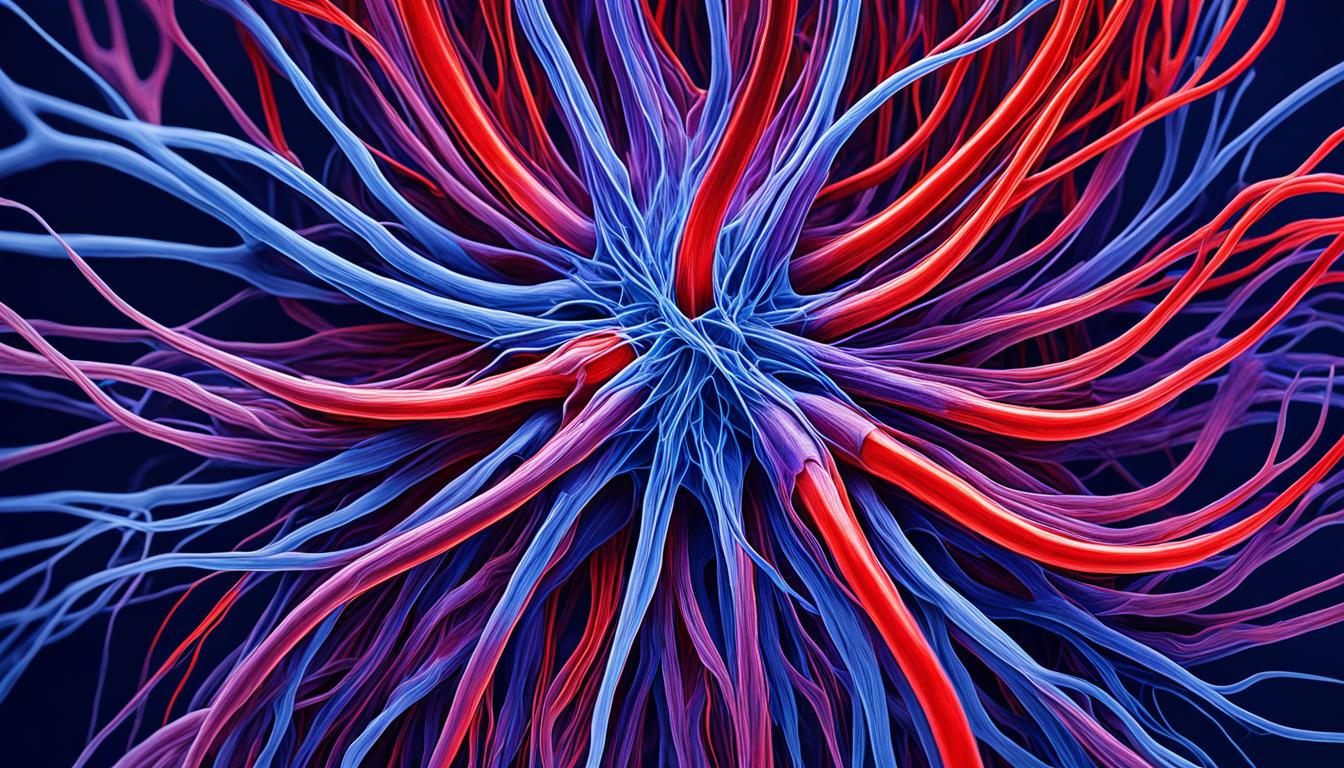Spinal arteriovenous malformation (AVM) is when blood vessels tangle abnormally. This disrupts how arteries and veins join. It mostly happens in the brain and spinal cord but can occur elsewhere. People with spinal AVMs might not notice any symptoms. But, sometimes, the weakened blood vessels can break. This leads to spinal cord bleeding and various symptoms.
Signs of spinal AVMs can include seizures, headaches, and pain. You might also have visual and muscle issues, trouble speaking, or moving incorrectly. Sensations might feel strange, you could have thinking problems, feel dizzy, or even faint. Early diagnosis is key to choosing the right treatment.
AVM treatment varies based on AVM type, where it is, and the patient’s health. Stem cell therapy is one new option showing hope. It works by using stem cells to fix damaged cells. This aims to boost function in spinal AVM patients. The goal is to find ways to significantly improve their quality of life.
Key Takeaways:
- Spinal arteriovenous malformation (AVM) is an abnormal tangle of blood vessels that disrupts the connections between arteries and veins.
- Most people with spinal AVMs do not experience noticeable symptoms, but in some cases, weakened blood vessels can rupture and cause bleeding in the spinal cord, leading to various symptoms.
- The symptoms of spinal AVMs can include seizures, headaches, pain, visual problems, muscle weakness, speech difficulties, movement problems, abnormal sensations, cognitive difficulties, dizziness, loss of consciousness, and developmental differences.
- Diagnosing AVMs is essential to assess the appropriate treatment options for each individual.
- Treatment for spinal AVMs depends on factors such as the type, location, and symptoms of the AVM, as well as the individual’s overall health.
- Stem cell therapy is a potential treatment option that aims to replace damaged cells and improve overall function in individuals with spinal AVMs.
Risk factors and complications of spinal arteriovenous malformation (AVM)
Spinal arteriovenous malformation (AVM) is a condition involving the blood vessels. It can cause serious problems. Knowing the risk factors can help prevent these issues.
Spinal AVM Risk Factors
There are several things that could raise your chances of getting a spinal AVM. These include:
- Genetic predisposition: Some genetic disorders, like hereditary hemorrhagic telangiectasia (HHT), make you more likely to have spinal AVMs.
- Prior blood vessel issues: If you’ve had blood vessel problems before, it increases your spinal AVM risk.
- Age: This condition is often found in people aged 30 to 50, but it can occur at any time.
- Gender: It’s more common in men than in women.
Complications of Spinal AVMs
Spinal AVMs come with their own set of problems. They could lead to:
- Spinal AVM Hemorrhage: Bleeding from these weak blood vessels can cause serious issues in the spinal cord.
- Tissue Damage: The unusual blood flow from spinal AVMs can damage spinal cord tissues.
- Nerve Cell Death: This can lead to nerve cell death and neurological problems.
- Reduced Oxygen Supply: It can make it harder for the spinal cord to get enough oxygen, causing further harm.
- Compression: Spinal AVMs might press on the spinal cord and nearby nerves, causing more problems.
Some people with spinal AVMs won’t have any symptoms. However, others may face severe issues or, in some cases, death. Early diagnosis, proper care, and ongoing check-ups are key to avoiding complications and improving outcomes.
Section 2 discusses spinal arteriovenous malformations (AVMs) and their dangers. It points out the high risk of hemorrhage and lists factors like genetic issues, age, and gender that raise your risk. The text also explains the complications that may happen. It stresses the need for quick diagnosis and treatment. An image related to spinal AVMs is included for more understanding and interest.
Treatment options for spinal arteriovenous malformation (AVM)
The treatment for spinal arteriovenous malformations (AVMs) depends on many things. These include the AVM’s type, where it is, and its signs. It also depends on how healthy the person is. Doctors will look into these things to find the right treatments.
People with AVMs that show no symptoms might not need treatment right away. They might be told to get check-ups and tests often. This is to make sure the AVM isn’t causing any problems.
If the AVM needs to be treated, doctors might decide to remove it by surgery. This helps get rid of the bad blood vessels. Another way is by using a tiny tube to close off the AVM without surgery.
Radiation therapy is another choice for treating spinal AVMs. It uses focused radiation to make the bad vessels smaller. The best treatment is picked based on many things. Doctors will work with the individual to plan their treatment.
The outlook for people with spinal AVMs can change based on many things, like the AVM’s size and where it is. Also important is how well the person responds to the treatment. Talking with healthcare experts is key to figuring out the best treatment and outlook for spinal AVMs.

